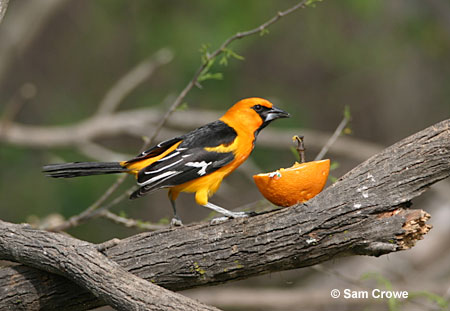How to Attract Birds

Feeding and watching birds is one of the most popular hobbies in the United States. Some of the reasons for its popularity include:
- The birds are beautiful
- Bird behavior is interesting
- It is an inexpensive hobby
- Almost anyone can do it
- High ‘enjoyment return’ for time invested
One of the very best side effects is that the more you do to attract more and different birds, the better it is for the birds! A real win-win situation.
In this section we will provide information on how to attract both more birds and a greater variety of birds.
Remember to feed responsibly by keeping your feeders and birdbaths clean.
Select from the menu items on the left for detailed information. If you are just beginning to feed birds, here are a few things you should know.

An Altamira Oriole enjoying an orange. Orioles can be attracted by oranges, grapefruit, or even grape jelly!
What you don’t know you don’t know – about attracting birds.
Benefits to the birds…
Loss of habitat is one of the greatest threats to birds. By developing your ‘backyard habitat’ you can help make up for the losses in natural habitats. The food, water and cover you provide can be especially helpful during these periods:
- Winter, when food and water may be hard to find. Offer water in a heated bird bath through the winter.
- Spring and fall migration, when birds are burning lots of energy during their migratory journeys that may cover thousands of miles in a single year.
- Nesting. Cover can provide nesting locations, attract insects for insect eating birds and provide seeds for seed eaters.
Benefits to you…
- In addition to being just plain fun, watching birds can help relieve stress.
- Watching birds at a feeder or birdbath can be a family experience, with kids, parents and grandparents.
- Watching birds can often be a spark that gets kids kids interested in nature and the outdoors. More and more research is revealing the real health benefits to kids spending more time in the outdoors.
The three ingredients for attracting birds…
- Cover: The most important element in attracting birds. Cover provides a place for birds to hide from predators and bad weather, a place to nest and often insects and seeds for the birds to eat. Select the Habitat link on the left for additional details. Visit the Gardening for Birds section for specific gardening information.
- Water: Adding a water feature to your backyard is the second best way to attract more birds, and a greater variety of species. Adding an on-ground birdbath with a waterfall rock or dripper is sure-fire method to attract more birds.
- Food: Food is the third most important element (in most cases) for attracting more birds. The Food section will provide you with detailed information on which foods are best for which species.
The best situation, of course, is to offer all three elements. The birds will thank you for it.
Issues you may face…
These are some of the problems you may face if you feed birds. There are good solutions to all of them, detailed in the sections on Food and Feeders.
- Squirrels – Squirrels can consume large quantities of sunflower seed.
- Rodents – In some cases, large amounts of dropped seeds can attract rodents.
- Germinating seeds – Seeds that fall under feeders may germinate.
- Less-desirable birds – Introduced species such as House Sparrows and starlings can sometimes dominate a feeder.
- Improper seed choices – Bird feed sold in grocery stores and discount stores is often not appropriate for hanging feeders. Check the ingredients before you buy. Seeds like milo and millet are best served on the ground and are most popular with sparrows and doves.
All of these problems can be easily solved or greatly reduced by the appropriate selection of feeder and feed. Well, most of them anyway. You may find that squirrels are a formidable foe, but then they can be fun to watch also.
Quick tips on how to attract birds
Bird baths
Bird baths provide water for drinking and bathing. Add the sound of moving water by adding a dripper or mister to the bird bath. Provide open water in your bardbath in the winter. Birds that will not visit your feeders will visit a bird bath.
Bird Feeders
The are several different bird feeder styles, including hopper, tube and platform. Each bird feeder design has its own set of advantages and drawbacks. Wooden bird feeders are often in the style of platform or hopper feeder. Some wooden bird feeders are very elaborate in design. Treated wood should not be used in a bird feeder. The section on bird feeders has the information you need to make an informed selection.
What do birds eat?
Birds eat a mix of seeds, fruit and insects. Offering several different types of bird food will help attract the greatest variety of birds. Start by using black oil sunflower. Then mix in suet cakes, nyjer seeds, peanuts, and even fruit.
